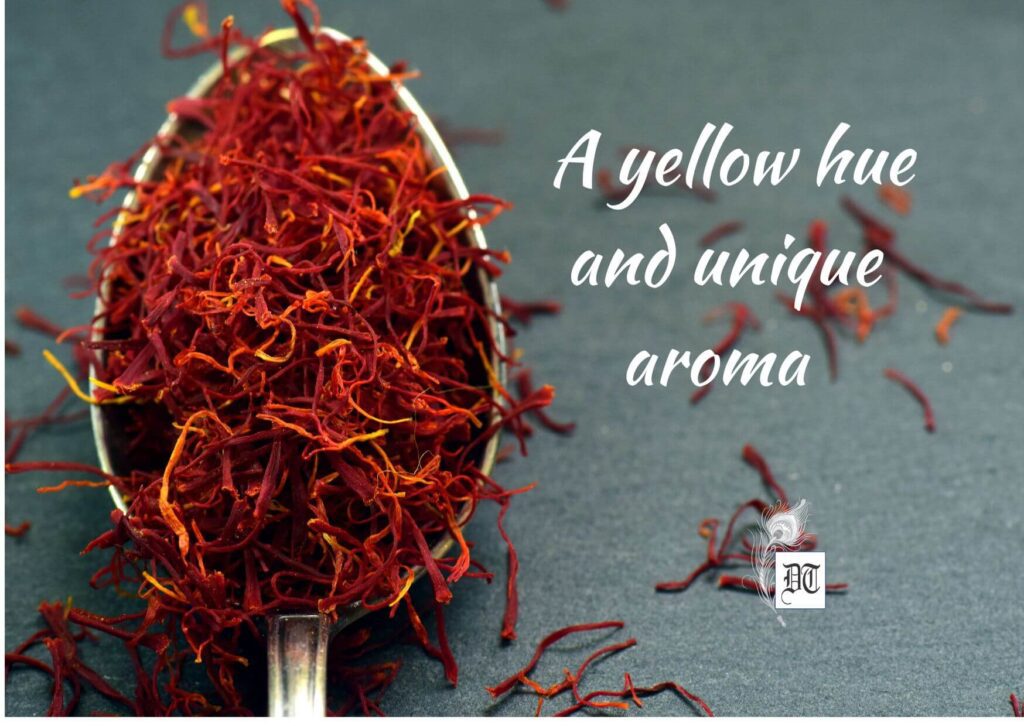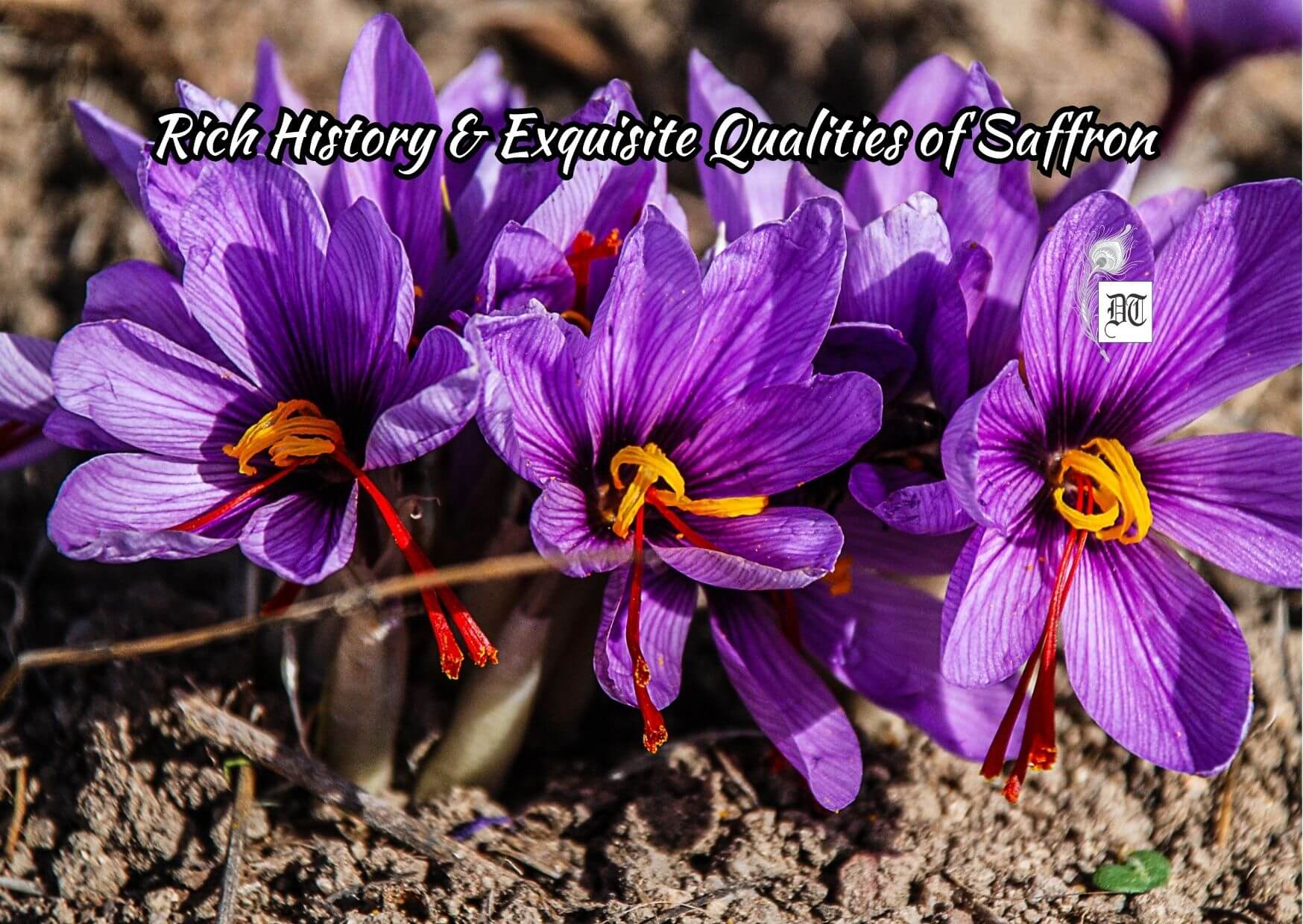Reading Time: 3 minutes
Saffron has a long history of medicinal and religious significance, and Zafran Kahwa is a testament to its allure, informs Monika – exclusively for Different Truths.
Saffron is a vaunted and one of the most exquisite spices in the world. Its high price is due to its labour-intensive harvesting method, which makes for its production costs. It takes almost 75,000 to one lakh flowers to produce one pound of saffron because each bloom yields only three fragile stigmas. The mauve-coloured perennial flower is a triploid with three sets of chromosomes. That also suggests it’s sterile and needs human intervention to reproduce.
Saffron belongs to the family Iridaceae (syn – kesar), and the flower is called Crocus sativus, also known as the Saffron crocus. It is believed yet debated that saffron originated and was first cultivated in Greece during the Bronze Age. Still, today the spice is primarily grown in Greece, India, Iran, and Morocco. At the same time, micro-scale production of saffron does exist in NZ, Tasmania, and US. Saffron is now considered a native of Southern Europe and cultivated in Mediterranean countries, particularly in Spain, Austria, France, Greece, England, Turkey, and Iran. Iran produces almost 80-85 per cent of the world’s saffron. It is cultivated in India in Jammu & Kashmir and Himachal Pradesh. Saffron thrives best in warm sub-tropical climates.
The word ‘saffron’ comes from the Latin ‘Safranum‘…
The word ‘saffron’ comes from the Latin ‘Safranum‘, derived from the ancient French term ‘Safran’ from the 13th century. ‘Safranum‘, in turn, comes from the Persian (za’ferân). Some argue that it eventually came from the Arabic word (za’farān), which is itself derived from the adjective (asfar, “yellow”). However, some linguists claim that (Za’faran) is the Arabic form of the Persian word (zarparān) – “with yellow leaves”. Latin ‘Safranum‘ is also the source of the Italian ‘Zafferano‘, Portuguese ‘Açafrão‘ and Spanish ‘Azafrán‘.
The name of the genus’ crocus‘ is derived from the Greek word (Krokos), a lended word from a Semitic language, related to the Hebrew word (Karkom), the Aramaic word (Kurkama) and the Arabic (Kurkum). Eventually, these words can be traced from the word (Kunkumam) from Classical Sanskrit, meaning ‘saffron’ or ‘saffron yellow’.
According to legend, it’s believed that in the fifth century BC, an arhat Indian Buddhist missionary, Madhyântika, was sent to Kashmir. Probably it was he who sowed the first Kashmiri saffron crop. From then onwards, saffron use spread throughout the Indian subcontinent.
The dainty lacelike crimson stigma magically imparts a yellow hue and unique aroma to whatever it is added.
The dainty lacelike crimson stigma magically imparts a yellow hue and unique aroma to whatever it is added. The taste of Saffron is extraordinarily subtle and aromatic. The sweet and appetising taste is enigmatically luxurious. Sometimes describing the flavour is ticklish, but it’s instantly recognisable (if used) in any exotic dish. Saffron has a distinct flavour, bursting with a vibrant, smooth texture.

People would consume saffron to elevate their mood and improve memory and libido. It’s rich in antioxidants, protecting our body cells against free oxidative stress. It’s supposed to have anti-depressive and aphrodisiac properties. Smelling and eating saffron help treat PMS symptoms, headaches, cravings, pain, and anxiety.
Legendary lore annotates that Queen Cleopatra used to bathe in saffron sourced in milk to keep herself fair-skinned and youthful.
Legendary lore annotates that Queen Cleopatra used to bathe in saffron sourced in milk to keep herself fair-skinned and youthful. The Great Alexandra used saffron as an antiseptic to heal his battle wounds faster. During the Aegean Bronze Age (3000 to 1000 BC), the Minoans and the Mycenaeans, who lived on the island of Crete in Greece, used to burn saffron as incense.
During the European Middle Ages, spice was introduced to Spain by Arab people and was enjoyed throughout Western Europe as a delicacy, dye, and mood enhancer. Saffron has been used as a fabric dye, particularly in China and India, and perfumery.
Its mention is in the Bible (Song of Solomon 4:14), where a lover in a poem compares his lady love to the exquisite, sweet-scented spice. It was a constituent of ‘kyphi‘, an incense used in ancient Egyptian temples dedicated to the goddess Isis. It is used for Hindu religious purposes in India as an essential ingredient for Havana / Yagna rituals. They believe that this fire purifies the whole environment. It produces a divine light symbolising the purity of the fire. Hindu devotees also smear Saffron paste on their foreheads during critical religious rituals.
Saffron is mentioned in 1600 BC in ancient Chinese scripts and herbal encyclopaedia, named Shennong Benjoying…
Saffron is mentioned in 1600 BC in ancient Chinese scripts and herbal encyclopaedia, named Shennong Benjoying too, where Kashmir was named as the land of saffron and its offering to Buddha. Historians believe that the Mongols first took saffron from Iran to other lands.
The famous, exquisite hot beverage ‘Zafran Kahwa‘, which finds its genesis in Kashmir, is loved worldwide.
Picture design by Anumita Roy
















Prose as worthy as saffron itself – thank you! And well researched and explained.
Thank you, Azam Gill Sir. I’m humbled by your compliment. It means a lot.